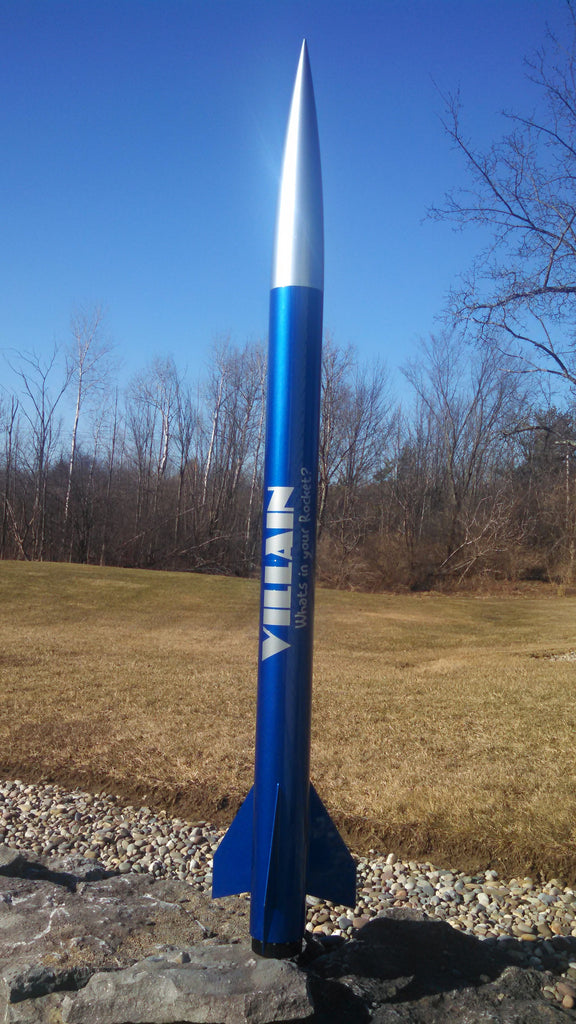patelldp
Well-Known Member
- Joined
- Jan 23, 2009
- Messages
- 5,647
- Reaction score
- 101
As I alluded to in my 3" MAC Arcas build thread, I picked up my very own 4" MAC Villain from Mike. The kit is typically 66" long (27" booster, 20" payload), but I custom ordered it 21" longer with a 48" booster. This will permit me to use motors like a 54-2550 with an adapter or a 76-6000 someday. The kit looks great at the stock length, I just wanted to have a little more flexibility. A few messages between Mike and myself and I had my custom length kit...and you can too! Give Mike a ring or an email and he'll work with you!!!
Just to start, here's the run down on the rocket (from the MAC Performance Rocketry website, www.macperformancerocketry.com
Specifications:
Length: 66 inches (87" for my kit)
Dual Deployment
Motor Mount: 75mm
Approximate Weight: 64 oz (TBD for my kit)
Will fly on I through L motors (Mike texted me to correct me...my custom long kit will take an M...)
Content of Kit:
27" x 4" canvas phenolic booster tube (48" for my kit)
20" x 4" canvas phenolic payload tube
75mm x 16" kraft phenolic motor tube
5:1 Pinnacle nosecone -- 19 1/2" exposed
(3) 1/8" G10 beveled fins
3/8" fore C ring with integrated shock cord attachment system that includes 9/16" tubular nylon booster harness
1/4" mid C ring
3/8" aft C ring with a step machined in the OD to double as a thrust plate
3/8" altimeter bay bulkheads with machined step to engage coupler
4" x 1" switch band
8" long machined XX phenolic coupler/altimeter bay
Altimeter bay includes: (2) aluminum 1/4" all thread rods,
3 1/2" x 6" canvas phenolic altimeter sled with standoffs
Includes all necessary hardware (does not include motor retainer)
Assembly instructions included

Next post: Pictures of my kit and the adhesives I'll use in the build!
Just to start, here's the run down on the rocket (from the MAC Performance Rocketry website, www.macperformancerocketry.com
Specifications:
Length: 66 inches (87" for my kit)
Dual Deployment
Motor Mount: 75mm
Approximate Weight: 64 oz (TBD for my kit)
Will fly on I through L motors (Mike texted me to correct me...my custom long kit will take an M...)
Content of Kit:
27" x 4" canvas phenolic booster tube (48" for my kit)
20" x 4" canvas phenolic payload tube
75mm x 16" kraft phenolic motor tube
5:1 Pinnacle nosecone -- 19 1/2" exposed
(3) 1/8" G10 beveled fins
3/8" fore C ring with integrated shock cord attachment system that includes 9/16" tubular nylon booster harness
1/4" mid C ring
3/8" aft C ring with a step machined in the OD to double as a thrust plate
3/8" altimeter bay bulkheads with machined step to engage coupler
4" x 1" switch band
8" long machined XX phenolic coupler/altimeter bay
Altimeter bay includes: (2) aluminum 1/4" all thread rods,
3 1/2" x 6" canvas phenolic altimeter sled with standoffs
Includes all necessary hardware (does not include motor retainer)
Assembly instructions included

Next post: Pictures of my kit and the adhesives I'll use in the build!
Last edited:




































